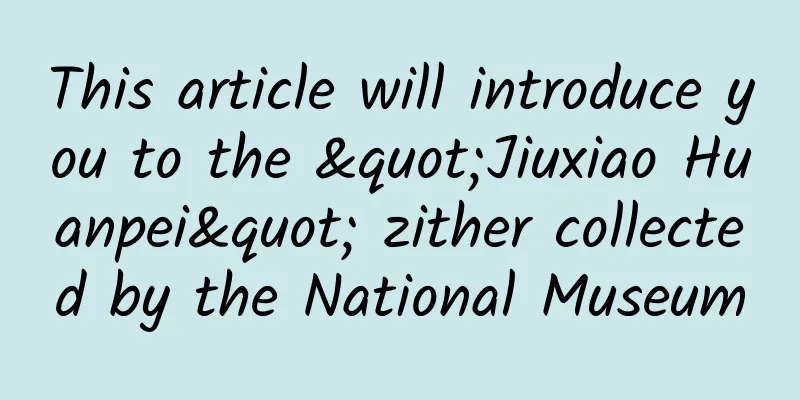This article will introduce you to the "Jiuxiao Huanpei" zither collected by the National Museum

|
A brief study on the “Jiuxiao Huanpei” zither collected by the National Museum of China (Part 2) Scholars of Lü Zhi Culture Tang Dynasty "Leiqin" The so-called "Leiqin" refers to the ancient guqin made by the Lei family of Western Shu during the Tang and Song dynasties. Legend has it that in ancient times, the Shu region had already formed a trend of "loving to play the guqin". In the following dynasties, the making of guqin was extremely prosperous. In the Sui Dynasty, King Yang Xiu of Shu summoned craftsmen from all over the country to gather in Shu, "making thousands of guqins and spreading them around the world". In the Tang Dynasty, Shu produced many famous guqin makers. Among the many famous zither makers in Shu, the Lei family is the most famous. In the literary criticism of the Song Dynasty, there are many words praising the Lei family's zither making. For example, in the "Huang Chushi" in Volume 10 of Huang Xiufu's "Thatched Pavilion Guest Talk" in the Northern Song Dynasty, it says: Huang Chushi's name is Yanju, and his courtesy name is Chuifan. He is from Meiyang. He became a monk when he was young. He was eccentric and simple. He often said: "My family has been practicing righteous music since the Tang Dynasty. They have been waiting for orders in Jinmen. My father followed Emperor Xizong to Sichuan, and it has been four generations since then. The most prosperous zither is in Sichuan. There are several families making and carving zithers, but only the Lei family. It is also said that the Lei family's zithers are not necessarily perfect. The ones with 瑟瑟徽 are the best, the ones with gold and jade are the second, and the ones with snails and clams are the third. The reason why they are different is that although the peak is high, the strings are low. Although they are low, they do not hit the face. When you press it, it feels like there is no string under your fingers. When you hum and vibrate it, there is a lingering rhythm. If it is not the Lei family, the sound of the zither will never have the rhythm of the zither. Su Shi's "Dongpo Zhilin" records that the Lei family in Shu was famous for their tradition of making guqins. From the Kaiyuan period of Emperor Xuanzong of Tang (713-741) to the Kaicheng period of Emperor Wuzong of Tang (836-840), for more than a hundred years, the Lei family had people making guqins every generation. Huang Tingjian wrote in his poem "Yuzhi Garden": I love your Lei’s zither, and its red strings are so loud. Regarding the "Lei's Qin", the later Shuzhong scholar Ren Yuan commented in his "Notes on Shan Gu Nei Ji Shi" as follows: Lei Shi, a native of Shu, was good at making zithers, which were treasured by the world. After the An-Shi Rebellion in the Tang Dynasty, Lei Yan, a famous zither maker from the Lei family in Western Shu, was summoned by Emperor Xuanzong to the inner court and appointed as "Guqin Waiting Zhao". Perhaps for this reason, the zithers made by the Lei family were more respected and loved by zither players, and gradually became known as "Leiqin", "Lei's zither", "Leigong zither", etc. Later generations of literati even praised him as "Leigong is the best zither in the Tang Dynasty, and the Nine Lei in Shu are the best". Su Shi once collected a "Lei Qin" dated to the 10th year of Kaiyuan (722), on which the inscription reads: Built in the 10th year of Kaiyuan, inscribed by the Lei family of Lingguan Village, Yazhou. Even the great writer Su Dongpo was not clear about the meaning of the three words "八日合" in the inscription. In his poem "Writing after Waking Up from Sleeping During the Day", Lu You, a poet of the Southern Song Dynasty, wrote that he had no choice but to pawn his treasured "Leiqin" in order to earn money for his family's livelihood. However, Lu You still missed his beloved item from time to time, and "suddenly an old friend gave him rice", so he did not care about using it for other purposes, and "called his son to discuss redeeming the Leiqin first", which shows how much he cherished the "Leiqin". The "Leiqin" has a special artistic effect in the performance of music, so it has been highly praised by later scholars and poets. The "Shuo Fu" Volume 100 compiled by Tao Zongyi, a scholar in the late Yuan Dynasty and early Ming Dynasty, quoted the "Qin" entry in "Yuefu Miscellaneous Records" by Duan Anjie of the Tang Dynasty: In ancient times, there were many talented people. During the Zhenyuan period, there was a man named Lei Sheng from Chengdu who was good at making zithers. Even today, his descendants still have a legacy and continue to make zithers. Their craftsmanship is unmatched anywhere in the world, and many people play them. Volume 82 of Shuo Fu quoted Ouyang Xiu's "Six One Layman's Poetry Talk" in the Northern Song Dynasty: My family has an old zither, which was made by Lei Hui in the third year of the Baoli period, 250 years ago. Its sound is clear and melodious, like striking metal or stone. It can be seen that people treasure the "Leiqin" because of its "clear and melodious" sound like gold and stone, "exquisite and unparalleled in the world." Zhu Yi of the Southern Song Dynasty also recorded in Volume 1 of "Yijueliao Miscellaneous Notes": The Tang Dynasty Lei family's zithers that have survived to this day are all treasures. The Biography of Nangong Sheng written by Gao Qi in the late Yuan Dynasty and early Ming Dynasty says: He set aside a room to store calligraphy from past dynasties, Zhou Dynasty bronze vessels, Han Dynasty inkstones, and Tang Dynasty Lei's zithers, and spent his days wandering around there to entertain himself. ... His surname was Song, his given name was Ke, and his courtesy name was Zhongwen. He lived in Nangongli, so he called himself Yun. Wu Sidao, a contemporary of Gao Qi, wrote in the fourth volume of Chuncaozhai Collection, “Three Generations of Thunder Records”: The third generation of Lei is also called Qin. It was made by Lei Zhen of Yuzhou in the Tang Dynasty. Later, his son, a certain person, repaired it, and his grandson, a certain person, repaired it again. Looking from the side, the inscriptions were all there. The person who got it was surprised that three generations of the Lei family came from the same instrument, so he named it after it. The bottom was engraved with small seal characters. Some people say that Zhen started making Qin from his ancestor, and Zhen is the third generation. Although the material is tung wood, the tail is sea rattan, the knee is black jade, the broken pattern is snake belly, and the style is Xuan Ni. It is less than five feet long, but the sound is like gold and stone, clear and far-reaching. Zhu Yi regarded the "Lei Qin" as a treasure, and Nangong Sheng treasured it, which shows that people in the world love the "Lei Qin" of the Tang Dynasty. According to the record of Wu Sidao's "Three Generations of Lei", some people even took tricks and robbed others to get the famous "Three Generations of Lei". The reason is that the "Lei Qin" has a clear and distant sound of metal and stone. The reason why the ancients attached the most importance to the "Leiqin" of the Tang Dynasty was because the golden age of "Leiqin" making was in the Tang Dynasty. The "Leiqin" of the Tang Dynasty had the highest craftsmanship and the best performance effect. Because of the unique sound of the "Leiqin" in the Tang Dynasty, later generations have explored it. According to the "Tai Gu Zheng Yin Qin Jing" written by the Ming Dynasty, a monk in Shu wanted to verify the sound principle of the "Leiqin" and had to dismantle his treasured "Leiqin" to find out the truth: Its peak cannot be reached by a finger, and the string does not retract. Its sound comes from between the two pools. Its back is slightly raised, like a leek leaf. The sound wants to come out but is narrow, lingering and lingering, leaving a lingering rhythm. It is so exquisite. According to historical records, the making of the "Lei Qin" also carries a certain mysterious color. For example, in the first volume of "Xixi Congyu" by Yao Kuan of the Song Dynasty, it is said: Zhao Yan'an, a hermit in Yundang Valley, Tianhudian, Yinan, found a qin with strange and ancient inscriptions, which was really a snake worm. The sound and rhyme were majestic and far-reaching, and the three words "Wuzhong Mountain" were inscribed in the middle, but no one knew what they meant. Later, I found a record in "Caotang Xianhua" of Shu County: "Most of the qins made by the Lei family were in the three mountains of Emei, Wuwei and Wuzhong." Then I knew it was a Leiqin. The Yuan Dynasty scholar Yi Shizhen wrote in Jiashi Shuolin: Lei Wei made a zither in Wuwei Mountain. He tried to find the five notes with his fingers, but he could not get them right. While he was hesitating, an old man suddenly appeared beside him and said, "Shorten the top by one fen, make the head thick, and make the waist thin. Apply lacquer on the Ji day, and set the strings on the Wu day, then you may be able to play it." Then he disappeared. From then on, he made zithers according to the method, and all of them were excellent. They were called "Leigongzither" in the world. The first volume of Yibu Tanzi by He Yudu of the Ming Dynasty also contains the following: It is said that Lei Wei made a zither, but it was not necessary to make all the tung trees. On a snowy day, he would drink heavily, put on a straw raincoat and go alone to the deep pines in Mount Emei, and cut down the ones that sounded melodious and continuous, and then he would make a zither. Someone who loved it the most named it "Songxue", so it is called "Lei Wei's zither". It can be seen that the secret of Lei's zither making is first of all to be good at selecting good materials from nature. The process of selecting materials is a process in which the zither maker goes alone and encounters natural things. This is a kind of poetic search and discovery, and also a kind of fate that can only be encountered by chance. There were many famous zither makers in the Lei family in Shu during the Tang Dynasty. In the Ming Dynasty, Zhang Yingwen recorded in the book "Explanation of Famous Zither Makers" in the second volume of "Qing Mi Zang": Famous zither makers include Cai Yong of the Han Dynasty, Zhao Yeli of the Sui Dynasty, Lei Xiao, Lei Sheng, Lei Wei, Lei Jue, Lei Wen, Lei Xun of the Tang Dynasty... I hope they are all among them. However, although they are all “Lei Qin”, in the eyes of the qin players of all generations, the “oldest ones are the best”, that is, the qins made by the first and second generations of Lei Qin makers are the best. In this regard, Su Shi explained the reason in “Dongpo Zhilin”: However, their descendants gradually became interested in profit, followed the trends and lost family rules. Therefore, they regarded the oldest ones as the best, not valuing the distant ones and despising the near ones. As Lei's descendants "gradually became obsessed with profit" and "pursued worldly favors" and even "lost the family rules", the inheritance of "Leiqin" came to an end in the late Tang Dynasty. The Elegant Meaning of "Nine Heavens Ring and Pendants" Since the "Jiuxiao Huanpei" zither in the Beijing Palace Museum has the highest exposure rate, many people mistakenly believe that "Jiuxiao Huanpei" refers specifically to this zither. In fact, "Jiuxiao Huanpei" is a very common name for a zither. The name "Jiuxiao Huanpei" is mentioned in the "Yaqin Minglu" written by Xie Xiyi of the Southern Song Dynasty. In the Tang Dynasty, "Jiuxiao Huanpei" was also a famous zither made by the Lei family of Western Shu. In the "Selected Words Carved on the Back of the Zither" in the "Wuzhizhai Qinpu" of the Qing Dynasty, "Jiuxiao Huanpei" was even ranked first. There are five surviving guqins named "Jiuxiao Huanpei" that are believed by the guqin community to have been made by the Lei family in the Tang Dynasty. Many of them are included in the book "Chinese Guqin Collection", as shown in the following table: The "Jiuxiao Huanpei" zither from the Tang Dynasty that has been handed down so far |||| [Tang Dynasty] "Jiuxiao Huanpei" Qin Fuxi style, collected by the Palace Museum in Beijing [Tang Dynasty] "Jiuxiao Huanpei" Qin Fuxi style Collection of Liaoning Provincial Museum [Tang Dynasty] "Nine Heavens Ringing Pendants" Qinfeng Style or Pili Style Shen Xingshun Collection [Tang Dynasty] "Nine Heavens Ringed Pendants" Qin Fuxi Style He Zuo Ruzang In his article “A Study on the “Jiuxiao Huanpei” Qin in Liaoning Provincial Museum”, Mr. Zheng Minzhong proposed that the length and curvature of the “Jiuxiao Huanpei” Qin in Liaoning Museum are very similar to those in National Museum of China, and that they seem to have been made by the same person. If you look closely at the two Qins, there is some truth to this. The "Jiuxiao Huanpei" zither is well-known for its elegant name and has a high status among the existing ancient zithers. Regarding the explanation of the name of the "Jiuxiao Huanpei" zither, Mr. Fan Ziye of the Chinese Academy of Social Sciences once pointed out that "Jiuxiao" means the highest point in the sky, a metaphor for a very high or very far place, and also refers to the residence of immortals, which is the paradise that people pursue and yearn for; "Huanpei" is the jade pendant worn by the ancients, and later mostly refers to the jade ornaments worn by women. Because the jade pendants worn by women are mostly ring-shaped, they are called "Huanpei". In fact, the so-called "Jiuxiao" and "Huanpei" are both common terms in the orthodox "Daoist Canon" of the Ming Dynasty, so the elegant name of Lei's "Jiuxiao Huanpei" zither actually embodies the idea of immortals being out of the world. In ancient poetry and prose, "huanpei" also usually refers to the ornaments of female gods and goddesses, such as Liu Jingshu of the Southern Song Dynasty in Volume 6 of "Yiyuan": Liu Yuan, courtesy name Youzu, was good friends with Emperor Wu when he was young, but he looked down on He Wuji, so they did not get along. So he went to visit Huqiu Mountain in Wu County, wanting to stay there. At night, he howled in the wind. He played the zither facing the moon on Jianchi. Suddenly, he heard the sound of rings and pendants: a woman wearing a purple silk dress, with a hairpin and a belt hanging down, said to Yuan: "The King of Wu loves his daughter, and she is willing to come to visit." Yuan said: "The King of Wu loves his daughter, isn't she Han Chong's wife Ziyu?" So he went with Yuan, and said to Yuan: "I heard that you get along well with Liu Yu, Yu is a king, but you are not good with He Wuji, this person may be a problem for you. If you return to the north to serve Wei, your official position in the court will not be less than that of Mu Bo." After he finished speaking, he suddenly disappeared. He was under a pine tree in a large mausoleum, about three miles away from Huqiu. Yuan went north to serve Wei, and was successively appointed as the governor of Qingzhou. Liu Yuan played the qin and whistled on the sword pond, which moved the goddess Ziyu, so she appeared in front of him and pointed out the direction for his future development. In the hazy moonlit night, the sound of the rings and pendants on Ziyu's silk clothes seemed particularly pleasant and beautiful. The poem "Sanzhou Rock" by Tang Gongzuo of the Song Dynasty says: Several springs have passed in the cave, and the old trees in front of the cave are thousands of feet tall. I don’t know what happened in the empty valley in the past, and who knows the heart of the hermit with thick brows. The waning moon shines on people and swallows the distant shadows, while the evening breeze blows dreams into the deep mountains. I must visit the immortals' house, to listen to the sound of pendants from the clouds. The poem "Female Fairy Picture" in Volume 3 of "Xiaoming Manuscript" by Zhu Chengyong, the King of Qin in the Ming Dynasty says: A blue bird flies outside the green peach blossoms, and the Golden Mother's unicorn chariot steps on the jade grass. The imperial edict has an appointment with Magu, and the weak current looks at Penglai Island from afar. The wind in the sky blows the colorful clothes, and the sound of the pendants in the sky is ringing. Shuangcheng held the jade ruyi in his hands, and called Ah Xiang to accompany him in front of the carriage. Dust cannot stain the essence of a precious stone, and one’s name is enshrined in the register of immortals from birth. The clouded windows and foggy pavilion separate us from the world, and the young man on the street feels sorry for himself. The swallows have left the Yao Chi and the green plumes are picked up. The sound of the jade flute stops and the colorful clouds float away. The balcony is always an absurd dream, why would a golden house need to house Gillian? The poem "Seeing the Moon on the White Lotus Pond on Mid-Autumn Festival" in Volume 8 of "Taiquan Collection" by Huang Zuo of the Ming Dynasty reads: The golden waves shine on Yuquan, and the moon is beautiful to both the world and the sky. The clouds have moved and the treasure mirror has left the box; the wind has calmed and the black pearl is in the abyss. Look at the laurel palace from the vast mountains and rivers, and listen to the fairy maidens in the sky. The lotus is not aged by the smoke and frost, and it shines even more brilliantly than before. It can be seen that the "rings and pendants" are full of fairy spirit, which is inseparable from people's imagination of Taoist gods. Since "Jiuxiao Huanpei" was widely circulated in ancient times, we can see the elegant name of this "Leiqin" in many documents, such as Tao Zongyi's "Shuo Fu" Volume 27: The envoy Wu Ju owned a zither made by the Lei family, which was named Jiuxiao Huanpei. "Jiuxiao Huanpei" is also recorded in "Nancun Chuogenglu" Volume 29 "Names of Ancient Qin" written by Tao. In the early Ming Dynasty, Li Changqi wrote in "Jian Deng Yu Hua": Shangguan Shouyu was a native of Yangzhou. He was a Confucian scholar in Kuizhang Pavilion and lived in Shuntian Pavilion. He lived next to Jia Xuzhong, a reviewer of the National History, in the east. Jia was a friend of Ke Jingzhong, a native of Fujian. He was good at poetry and painting. He had three ancient zithers in his collection, namely Qiongyaoyin, Huanpeiyin and Penglaiyin, all of which were authenticated by Jingzhong. "Huanpei Yin" may be related to "Jiuxiao Huanpei", and of course it is also a kind of "Leiqin". In addition, the first volume of Ming Dynasty scholar Zhang Yingwen's "Qing Mi Zang" also states: The nine-story rings and pendants, I don’t know when they were cut. Cecilia Lindqvist, a contemporary Swedish sinologist, also gave a relatively comprehensive explanation of the "Nine Heavens Ringing Pendants" in her book Guqin, as follows: Among all the ancient guqins in China's collection today, the most famous one is probably the "Jiuxiao Huanpei" from the Tang Dynasty. According to Chinese tradition, the number "nine" is an extreme number, which means "highest", and is therefore often associated with imperial power and the throne. For example, "Jiuding" means a national treasure, symbolizing the "nine heavens" of national power, which is equivalent to the "seven heavens" in Sweden. The "Jiuxiao" in the name of the guqin also refers to the extremely high sky and the fairyland; "Huanpei" is a jade ornament worn by ancient Chinese people on their waists, which can make a pleasant tinkling sound when they touch each other. On the belly of the "Jiuxiao Huanpei" zither in the collection of the Palace Museum in Beijing is an inscription by Su Shi, which reads: The spring breeze is gentle and soft, and the sound of rings and pendants is clear and melodious. The new swallows chirp behind the curtains, and the old dragons roar in the vast ocean. Su Shi's inscription on the belly of the "Jiuxiao Huanpei" zither in the Palace Museum, Beijing The poem gives an accurate description of the varied and beautiful sound of the "Jiuxiao Huanpei" zither. The sound of the "Jiuxiao Huanpei" zither may be as gentle as the spring breeze blowing on your face, or as pleasant as the ringing of immortal pendants, or as gentle as the murmur of spring swallows, or as low as the hum of an old dragon lurking in the sea. Indeed, Su Dongpo's poem can be the best interpretation of the elegant meaning of the name of the zither "Jiuxiao Huanpei". Afterword As one of the largest national museums in my country, the National Museum of China does not have many ancient guqins in its collection, but this "Jiuxiao Huanpei" guqin is the most beautiful among all. Even compared with the "Jiuxiao Huanpei" guqin in the Palace Museum in Beijing, this guqin in the National Museum of China is not inferior at all. In terms of the guqin style, lacquer, cracks, inscriptions, etc., the "Jiuxiao Huanpei" in the National Museum of China can be regarded as a model of "Leiqin" and can be used as one of the standard instruments for the identification of Tang Dynasty guqins. |
>>: Attention! There are changes to the working hours this week, and an important reminder →
Recommend
How does the "spin" on your head turn? It turns out to be related to the northern and southern hemispheres! ?
Looking at a newborn baby is an exciting moment f...
China Charging Alliance: Operation status of national electric vehicle charging and swapping infrastructure in July 2022
National Electric Vehicle Charging and Replacemen...
Advertising case of “Geshuixue” educational institution!
Due to the impact of the epidemic, the summer enr...
A brief talk about short video production, marketing and monetization!
Let me first tell you about my results so that yo...
What is a healing speaker? It can feel your mood
We all know that light and music have a great inf...
A case study on efficient advertising and customer acquisition optimization in the beauty industry!
With the development of society, the growth momen...
The first batch of new smart #5 was delivered nationwide. Ning Zetao appeared at the ceremony as a representative of the first batch of celebrity car owners
( November 20 , 2024 , Huzhou) Today, the luxury ...
The Earth's core is as hot as 6,800°C, but it is cooling down at an accelerating rate... Will all the heat be lost?
It is easy to go up to the sky but difficult to g...
Introduction and tips for iQiyi splash screen ads and information flow ads!
Often, advertisers will ask, iQiyi has so many ad...
Does light have its own festival? Today, let’s get to know the light around us again.
From lighting to energy, from medicine to communi...
How to remove the crayfish thread? Can I eat shrimp without removing the shrimp thread? Introducing four tips for cleaning shrimp threads!
Every May, crayfish start to be available on the ...
Electric Motorcycle News: MG ZS vs Honda XR-V finally surpasses Japanese cars in engine
Speaking of the MG brand, its brother Roewe may b...
Lao Duan said: The future of cable network is integrated TV
After the launch of iQiyi Ultra HD Box and TCL iQ...
How to make hotel management mini program and hotel accommodation mini program?
With the advent of well-known hotel brands, many ...
This dish looks ugly and "disgusting", but it is the "king of rice"! Thank you Zhejiang people
Have you ever eaten pork with preserved vegetable...









